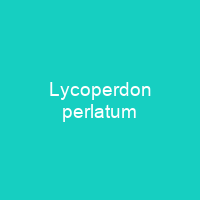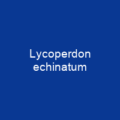Discovering Lycoperdon perlatum: The Common Puffball
Have you ever stumbled upon a round, spiny ball in your garden or on the roadside? That could be the common puffball, Lycoperdon perlatum. This fascinating fungus is not just a curious sight but also holds secrets of its own. Let’s dive into what makes this mushroom so intriguing.
The Morphology and Habitat of Lycoperdon perlatum
Imagine walking through a field or garden, and you come across a small, round object covered in tiny spines. Could it be the common puffball? This medium-sized fungus is quite the sight with its round fruit body tapering to a wide stalk. It’s like nature’s own little ball, but one that can grow up to 6 cm tall by 1.5 cm wide.
Where does it call home? Lycoperdon perlatum is quite the traveler, found in various environments such as fields, gardens, and even along roadsides. It’s a true cosmopolitan, with a widespread distribution that spans across continents like Africa, Asia, Australia, Europe, New Zealand, and South America.
The Edibility and Culinary Uses of Lycoperdon perlatum
Now, you might be wondering if this mushroom is safe to eat. The answer is yes, but with a caveat. When young and fresh, the common puffball can be quite delicious, offering a texture similar to sweetbread. However, careful identification is crucial as it must not be confused with poisonous Amanita species.
How do you prepare it? The fruit body of Lycoperdon perlatum contains chemical compounds that give it its unique flavor and odor. These include sterol derivatives and volatile compounds, making it a delightful addition to various dishes or even dried for later use. Just remember, the key is in recognizing it at the right stage.
Taxonomy and Phylogenetic Relationships
Let’s take a closer look at its taxonomic classification. First described by Christiaan Hendrik Persoon in 1796, Lycoperdon perlatum is not just any ordinary mushroom; it’s the type species of the genus Lycoperdon and has a close phylogenetic relationship with Lycoperdon marginatum.
What does this mean for its classification? The specific epithet ‘perlatum’ means ‘widespread,’ reflecting its cosmopolitan distribution. Its fruit body, ranging from pear-like to nearly spherical, is covered in short cone-shaped spines that can be rubbed off to reveal a netlike pattern.
The Spore Release Mechanism and Identification
As the puffball matures, it transforms into a brownish hue with a hole on top. This hole serves as its spore release mechanism, triggered by raindrops or compression. The spores are spherical, covered in minute spines, and contain threadlike filaments and club-shaped basidia.
How do you identify it? While the puffball is edible when young, there are several similar species that can be confused with Lycoperdon perlatum. These include Lycoperdon nettyanum, Lycoperdon pyriforme, and others listed in the text. Each has its unique characteristics, making careful observation essential.
Environmental Impact and Biochemical Compounds
The common puffball is more than just a tasty treat; it’s also an environmental indicator. It bioaccumulates heavy metals present in the soil, making it useful as a bioindicator of soil pollution by heavy metals and selenium.
What does this mean for its role? The fruit bodies contain steroid derivatives like ergosterol α-endoperoxide and (23E)-lanosta-8,23-dien-3β,25-diol. Volatile chemicals such as 3-octanone, 1-octen-3-ol, and (Z)-3-octen-1-ol give it its distinctive odor and flavor. Additionally, extracts from the puffball show relatively high levels of antimicrobial activity against human pathogenic bacteria.
Conclusion
The common puffball, Lycoperdon perlatum, is a fascinating fungus with a rich history and diverse applications. From its unique morphology to its culinary uses and environmental significance, this mushroom continues to captivate nature enthusiasts and researchers alike.

You want to know more about Lycoperdon perlatum?
This page is based on the article Lycoperdon perlatum published in Wikipedia (retrieved on November 28, 2024) and was automatically summarized using artificial intelligence.







